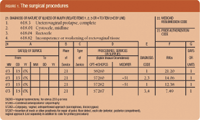Case Studies in Coding: More coding tips for colpopexy
In a previous article, we reviewed coding changes for vaginal colpopexy. This article looks at a related code introduced in CPT 2005 and how to report multiple services provided during the same surgery.
In a previous article, we reviewed coding changes for vaginal colpopexy. This article looks at a related code introduced in CPT 2005 and how to report multiple services provided during the same surgery.
Planning for surgery Ms. Rand, a 70-year-old established patient of Dr. Galt's, comes to the office for her pre-op visit on March 8. She was initially seen on March 1 for complaints of increasing vaginal pressure and discomfort, bladder pressure, and urinary frequency. She was noted to have significant protrusion beyond the introitus as well as cystocele and rectocele. After a discussion of management options, Ms. Rand elected to have a vaginal hysterectomy in addition to the primary repair procedures. Surgery was scheduled for 2 weeks later.
At the pre-op visit Dr. Galt discusses in detail with Ms. Rand the risks, benefits, and alternatives to the planned surgical procedures. The patient voices understanding and gives her informed consent. Copies of the signed consents, pre-operative orders, and the completed H&P will be sent to the hospital before her surgery.
He then turns to the anteroposterior repair. The anterior repair is completed without difficulty. Because the native tissues in the posterior compartment are found to be too weak to provide support alone, the decision is made to insert a mesh graft for the posterior repair.
A catheter is placed and left in for bladder drainage. The patient is taken to the recovery room in stable condition.
Postsurgical care Dr. Galt speaks with Ms. Rand's family, completes postoperative orders, and dictates the operative report. He sees Ms. Rand each day she's in the hospital and in the office for routine surgical follow-up.
Two months later, Ms. Rand returns after finding a lump in her right breast. She had a mammogram 10 months ago, which was normal. Dr. Galt reviews her records and performs a breast exam, which reveals a mobile, round mass in the right lower quadrant of the right breast. He orders a diagnostic mammogram, which is scheduled for the next day. Most of the visit is spent discussing further management options. Arrangements are made for Ms. Rand to see Dr. Rearden, a breast surgeon, for possible biopsy. Dr. Galt spends a total of 20 minutes with Ms. Rand.
How would you have coded this case? Read on for the report of services and an explanation of the codes.
Understanding the codes Global surgical care. A global fee for surgical procedures is a long-established concept under which a single fee is billed for all necessary services normally furnished by a surgeon before, during, and after the procedure. This is commonly referred to as a "surgical package." The specific services that are included in a particular surgical procedure may vary according to the type of procedure, where it was performed, and other factors that influence care. According to CPT guidelines, the following services are always included in a given surgical CPT code:
Although CPT guidelines state that the global surgical package begins 1 day before surgery, Ms. Rand's office visit 1 week before surgery and her hospital admission are part of standard surgical care. This preoperative work includes obtaining consents, completing hospital paperwork, and performing a preoperative history and exam. Therefore, the March 8 visit is not reported separately from the surgical procedure code. Dr. Galt would have reported the March 1 visit since it was to evaluate Ms. Rand's problems.
CPT guidelines define routine follow-up care to include "only that care that is usually a part of the surgical service." CPT does not specify the number of post-op days included in the package. This is determined by the third-party payer.
Medicare assigns global periods of 0, 10, or 90 days and includes follow-up visits that are related to the recovery from surgery. It also includes medical or surgical services performed for complications of surgery that do not require a return trip to the operating room. This is in contrast to CPT guidelines that specifically state that services rendered for complications or exacerbations should be reported separately.

"Add-on" codes are procedures that can only be reported in addition to another primary procedure. A modifier –51 is not used with these codes. Add-on codes are identified in CPT-4 by specific descriptors such as "List separately in addition to primary procedure," "each additional," and the + symbol. Code 57267 is a CPT add-on code; therefore, it's not necessary to append the modifier. Add-on codes are already discounted to reflect the fact that they are performed on the same day as another major procedure. The physician's fee is based on this reduced value, and the insurance company should not reduce the fee again.
Note that the CPT descriptor for code 57267 indicates the code should be reported for each site requiring the insertion of mesh or other prosthesis. If Ms. Rand's surgery had required another graft for the anterior compartment, then the code would have been reported twice. It would not be reported twice if two pieces of mesh were used as a graft for a single compartment.
CPT code 57282 was revised for CPT 2005 to distinguish between an extraperitoneal approach that uses the sacrospinous ligaments or the iliococcygeus and an intraperitoneal approach (CPT 57283) using the uterosacral ligaments or the levator musculature for the suspension points. This distinction provides a more specific way to report vaginal colpopexy procedures.
